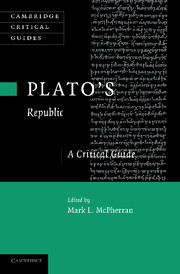Book contents
- Frontmatter
- Contents
- Acknowledgments
- List of contributors
- List of abbreviations
- Introduction
- 1 Socrates in the Republic
- 2 Platonic ring-composition and Republic 10
- 3 The Atlantis story: the Republic and the Timaeus
- 4 Ethics and politics in Socrates' defense of justice
- 5 Return to the cave
- 6 Degenerate regimes in Plato's Republic
- 7 Virtue, luck, and choice at the end of the Republic
- 8 Plato's divided soul
- 9 The meaning of “saphēneia” in Plato's Divided Line
- 10 Plato's philosophical method in the Republic: the Divided Line (510b–511d)
- 11 Blindness and reorientation: education and the acquisition of knowledge in the Republic
- 12 Music all pow'rful
- Bibliography
- Index of passages
- Index of names and subjects
2 - Platonic ring-composition and Republic 10
Published online by Cambridge University Press: 04 February 2011
- Frontmatter
- Contents
- Acknowledgments
- List of contributors
- List of abbreviations
- Introduction
- 1 Socrates in the Republic
- 2 Platonic ring-composition and Republic 10
- 3 The Atlantis story: the Republic and the Timaeus
- 4 Ethics and politics in Socrates' defense of justice
- 5 Return to the cave
- 6 Degenerate regimes in Plato's Republic
- 7 Virtue, luck, and choice at the end of the Republic
- 8 Plato's divided soul
- 9 The meaning of “saphēneia” in Plato's Divided Line
- 10 Plato's philosophical method in the Republic: the Divided Line (510b–511d)
- 11 Blindness and reorientation: education and the acquisition of knowledge in the Republic
- 12 Music all pow'rful
- Bibliography
- Index of passages
- Index of names and subjects
Summary
In Book I of the Iliad, anger and social rupture are transmitted in a chain reaction: from the grieving father Chryses to Apollo, from Apollo to Agamemnon and Achilles, from Achilles to his mother Thetis, and from Thetis to Zeus and the other gods. In Book 24 acceptance and reconciliation flow in the other direction, from the divine to the human. In Book 1, the aged Trojan priest Chryses travels to the Greek camp to ransom his daughter, and his pleas are rejected; in 24, the elderly Trojan king Priam travels to the Greek camp to ransom his dead son, and his pleas are accepted. In Book 1, Achilles quarrels publicly with his leader Agamemnon and rejects his role as warrior; he appeals to his divine mother Thetis, who appeals to Zeus on his behalf. In Book 24, Zeus directs Thetis to appeal to Achilles, who then reconciles privately with his enemy Priam and accepts his fate.
In short, the first and last Books of the Iliad are mirror-images of each other. Similar, though less marked, mirrorings structure Books 2 and 23, and to a lesser extent 3 and 22. The Iliad is thus structured by ring-composition, so that the work as a whole has the pattern ABCDCBA. Smaller ring-structures pervade it as well, most notably in the famous Homeric similes (in which, for instance, a warrior is likened to some force of nature, usually in an ABA pattern) and many of the important speeches.
- Type
- Chapter
- Information
- Plato's 'Republic'A Critical Guide, pp. 32 - 51Publisher: Cambridge University PressPrint publication year: 2010
- 1
- Cited by



